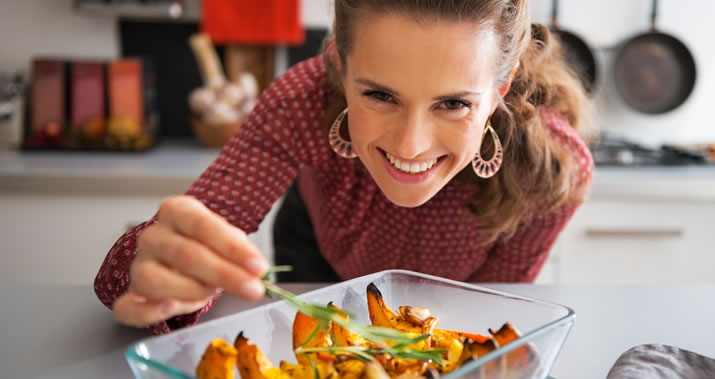
The Calorie Control Council reports that the average American will consume an overwhelming 4,500 calories feasting on Thanksgiving Day. While there is certainly nothing wrong with indulging in extra food on holidays, you should still be mindful about overdoing it. Here are some tips that will help you host a healthy Thanksgiving this season.
Portion Wisely
Thanksgiving feasts usually involve a wide-variety of side dishes, desserts and options. It’s acceptable to pile on the different types of foods so long as you remember to portion wisely. You will want to pick out enough vegetables to fill up around half of your plate. Hosts can serve colorful vegetables together in one dish with spices and herbs for a visually appealing and healthy side option.
One suggestion is to skip the foods that you can have all year long and fill your calories with the unique fall themed dishes instead. Opt for white meat instead of dark meat where possible, and try to resist the urge to go for second servings. You can enjoy all the different types of food options when you keep your portions small. Hosts should serve individual bite-sized portions of desserts rather than large pieces of pie to help reduce the portion size of your sweet snack.
Healthy Alternatives
Hosting a healthy Thanksgiving is a lot easier than ever before. When creating your Thanksgiving menu, hosts should search the Internet to locate recipes that call for healthy alternatives or substitute ingredients. Cranberry sauce, a Thanksgiving tradition, is often packed with sugar, but you don’t have to completely neglect the popular dish. Instead, choose a healthy homemade cranberry recipe to emulate.
You can also choose to substitute oil or butter with applesauce in different recipes to reduce the overall fat in your dishes. Switch out mayonnaise or sour cream with nonfat Greek yogurt, and substitute natural agave or stevia for sugar. Another great idea is to swap traditional salad croutons with unsalted nuts. Steaming your vegetables can help retain crucial nutrients that are often lost through boiling or other cooking methods. Take your time in planning out recipes, cooking methods and potential alternatives to ensure that you are consciously choosing the healthier option when possible. If you plan out your meal in this way, then you won’t have to be as picky or selective during the enjoyable feast!
Schedule Meal Time
Most people don’t think about the timing of their Thanksgiving feast playing a factor in their guest’s tendency to overeat, but it’s usually a huge factor. Many people will often forgo lunch for an early Thanksgiving feast, and this will cause them to be hungry enough to eat more than they would, had they eaten a proper lunch. Other times, a huge midday feast can cause excessive snacking around normal evening hours. Try setting your feast around the time that meals are normally eaten to curb any desire to over-do it.
Drink in Moderation
Researchers have discovered an interesting link between alcohol intake and the tendency to overeat. Studies have shown that alcohol consumption activates certain cells in the brain that are linked to hunger hormones. These triggers trick your brain into sounding the hunger alarm even when you are stuffed full of turkey. Indulging in a drink or two for Thanksgiving is acceptable, but remember to drink in moderation. Be mindful that drinking may trick you into believing you want that extra slice of chocolate pie when you probably wouldn’t eat it otherwise.
Portioning wisely, choosing healthy alternatives, scheduling the mealtime and drinking in moderation will all help you host a healthy Thanksgiving this holiday season. By curbing your desire to overindulge and remaining mindful about overdoing it, you are sure to have a healthier feast. You won’t even have to feel guilty about a little extra pie!